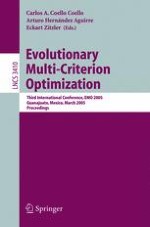2005 | Buch
Evolutionary Multi-Criterion Optimization
Third International Conference, EMO 2005, Guanajuato, Mexico, March 9-11, 2005. Proceedings
herausgegeben von: Carlos A. Coello Coello, Arturo Hernández Aguirre, Eckart Zitzler
Verlag: Springer Berlin Heidelberg
Buchreihe : Lecture Notes in Computer Science
